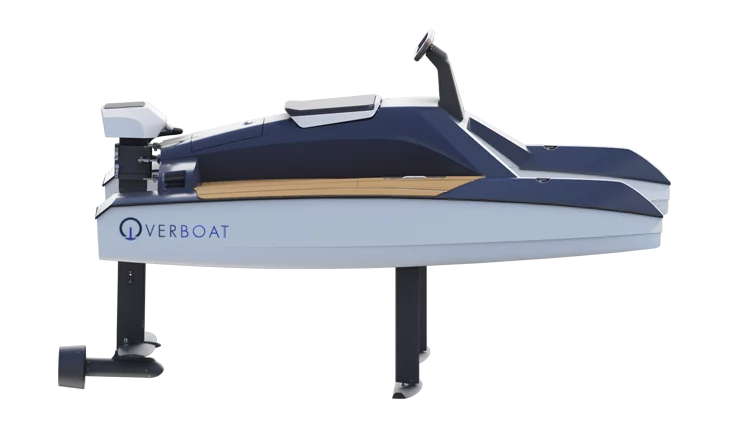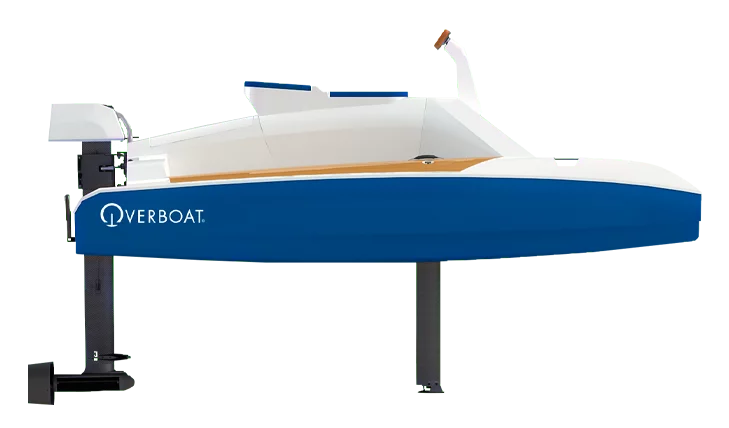Overboat
A new kind ofboating experience
Flying over the water from 5 mph to 23 mph for a thrilling ride
that creates no noise and no CO2 emissions
while respecting other boaters and underwater wildlife…
What’s not to like?
Overboat brought together the brightest talents in
underwater robotics, fluid mechanics, and hydrofoil automation
to develop a catamaran that will have you flying safely
above the waves at over 15 knots (about 17 mph)
in just a few seconds, with a stability you won’t find
in any other boat available today.
Since riding the Overboat does not need any training,
is accessible to everyone.
Its compact design, retractable foils and
electric propulsion system will let you fly
over the water for 2 hours (cruising speed).
Finally, you can have fun on the water without polluting,
making noise or disturbing others.
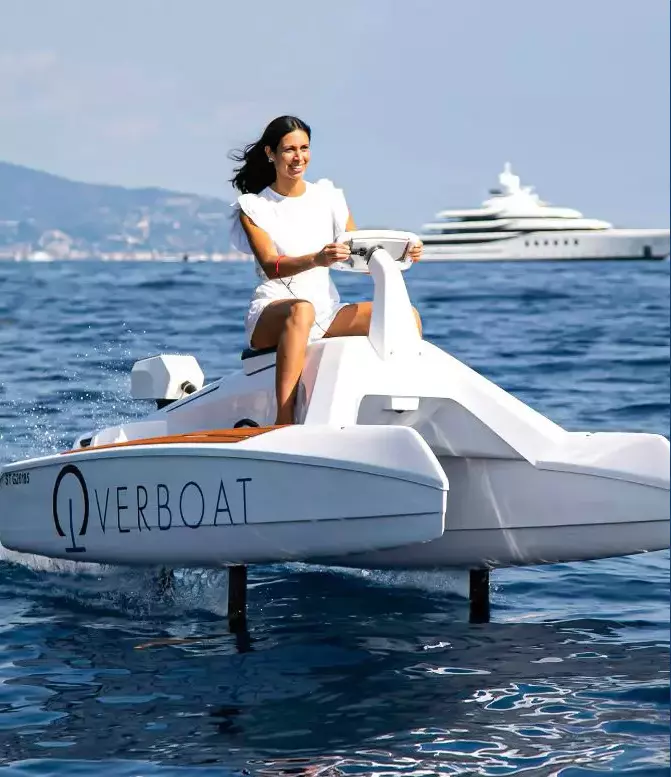
Respect for the environment
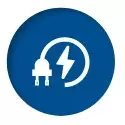
ELECTRIC PROPULSION
Eco-friendly, quiet, reliable

HYDROFOILS
Reduced wake: optimized energy use, smooth ride

AUTOMATIC SYSTEMS
Control foil stability, safety and performance

ZERO EMISSIONS
Respect of the marine environment

ZERO NOISE
100% electric personal water craft
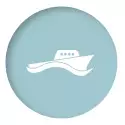
ZERO WAKE
Thanks to the hydrofoils
WOULD YOU LIKE TO TRY AN OVERBOAT FOR FREE BEFORE TO BUY IT?
CLICK IN THE BUTTON BELOW AND FILL THE FORM TO RESERVE AN APPOINTMENT FOR A RIDE, WE WILL GIVE YOU BACK THE MONEY FOR THE COST OF THIS SERVICE AT THE MOMENT YOU PLACE AN ORDER!!
Models
A broad range of options
FAQs
1. Is OVERBOAT an electric boat?
Yes, it’s a 100% electric catamaran that needs no fuel to run. It recharges just like an electric bike, by plugging into a standard outlet.
2. Do I need a permit to operate an OVERBOAT?
4. What category of watercraft is OVERBOAT?
Category D: in protected waters
These boats are designed to navigate in protected coastal waters, bays, lakes, rivers and canals. They are able to withstand winds up to force 4, established at 16 knots with gusts up to 23 knots, and waves with a significant height of 0.3 m or 12 inches (maximum 0.5 m / 20 inches). (The actual wave-clearing capacity of the hydrofoil watercraft is 0.8 m / 31.5 inches).
5. How much weight can an OVERBOAT handle?
For the Overboat 100F model we recommend a maximum weight of 100 kg (220 pounds).
For the Overboat 150F model we recommend a maximum weight of 150 kg (330 pounds).
For the models with hydrofoils, note that a boat designed to “fly” above the water needs to remain as light as possible for optimum performance.
6. How many people can ride on an OVERBOAT at once?
For the Overboat 100F model only one person can ride at a time. (Maximum weight of 100 kg / 220 lb).
For the Overboat 150F model two people can ride together. (Maximum weight of 150 kg / 330 lb).
7. Can I land an OVERBOAT on the beach?
No, the hydrofoils are built into the hull, so landing on the beach could damage them.
8. How old do I have to be to operate an OVERBOAT?
In Italy:
- For the Overboat 100F model ensure that the operator is at least 14 years old and that an adult is present to supervise any use of the OVERBOAT by minors.
- For the Overboat 150F model the operator must be at least 16 and have a boating permit.
For other countries, please inquire with the relevant regulatory authorities.
9. Can I brake on an OVERBOAT?
Watercraft do not have brakes – you can only decelerate. The only way to stop the boat cold is to pull the kill switch. This method is not recommended for stopping the boat during normal operation, but only in case of an accident or emergency.
10. Can I go in reverse with an OVERBOAT?
Yes, all OVERBOAT models are highly maneuverable, and you can put them in reverse if needed.
11. Do I need to wear a life jacket when using an OVERBOAT?
Yes, you must wear a personal flotation device (PFD) approved by the relevant authorities and appropriate for use with a personal watercraft. It is recommended that you wear protective clothing.
12. Do I need to wear a helmet to use an OVERBOAT?
It’s up to you to decide whether to wear a helmet when boating for fun.
13. What equipment do I need to have on the OVERBOAT?
We recommand you to check with your country rules.
14. Is it possible to fall off of an OVERBOAT?
The OVERBOAT is a boat, not a toy. Falling off or incorrect operation/driving may result in severe injury, which is why it is essential to use the OVERBOAT correctly. Pay attention to weather conditions and take the time to look at the water surface you’ll be travelling on. Don’t go out in winds higher than force 4 or if the waves are higher than a significant height of 12 inches, with occasional waves as high as 20 inches.
15. Is it possible for an OVERBOAT to capsize?
16. What brand of motor does OVERBOAT use?
17. What batteries do you use?
18. How long does it take to recharge the batteries?
The battery charge time is 1 hour and 45 minutes to go from a 20% charge to 100%.
19. Is the electric motor powered by an onboard battery?
20. Are the batteries removable?
For the Overboat 100F model there are three 22-pound removable batteries.
They can be changed out in 2-3 minutes.
The Overboat 150F model has a single 132-pound battery that is not removable. You will need to moor the boat for the full recharging time (about 1 hour 45 minutes with the faster charging device) before going out again for a maximum cruising time of 2 hours.
21. How long is the battery’s lifespan?
The lifespan is 1000 charge-discharge cycles (after which the batteries will operate at less than 70% of their initial capacity).
22. Are the hydrofoils retractable?
Yes, the 2 front hydrofoils can be easily folded up like a small centerboard.
The foil/rudder blade/motor assembly at the rear is heavier, but we have incorporated a simple and easy-to-use patented foldaway system with a rope, pulley and handle.
The OVERBOAT’s hydrofoils are completely retractable,
allowing for easy launching and use in shallow water.



